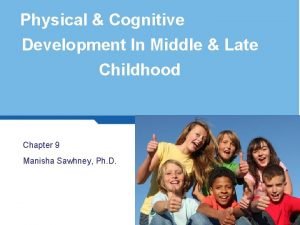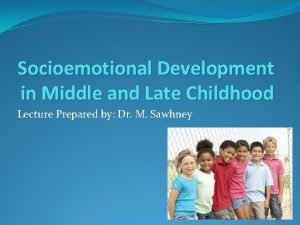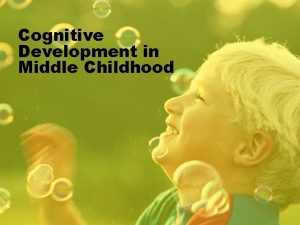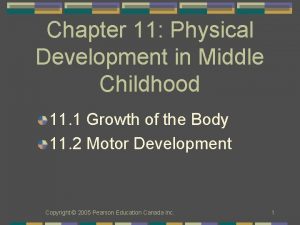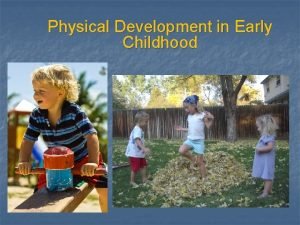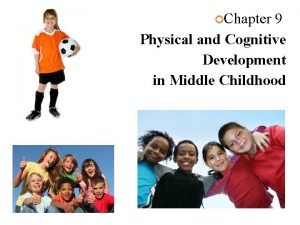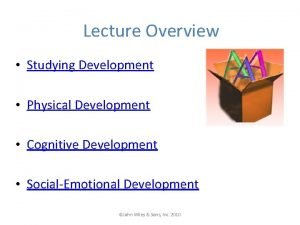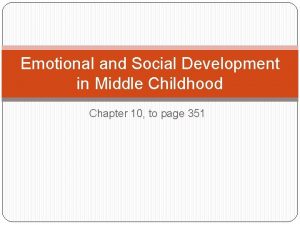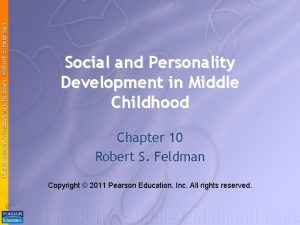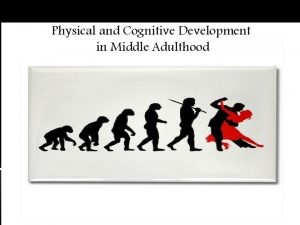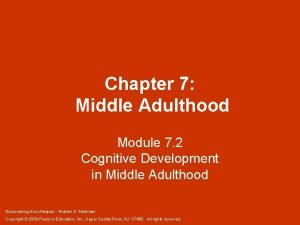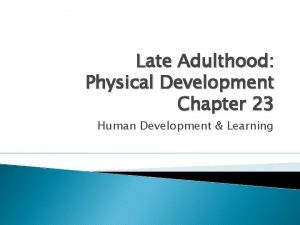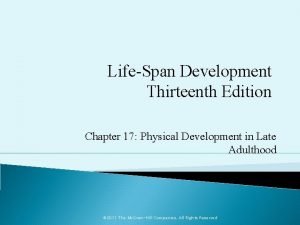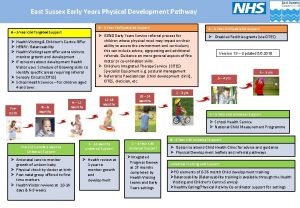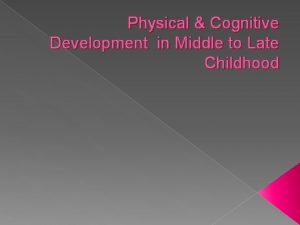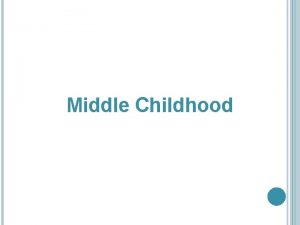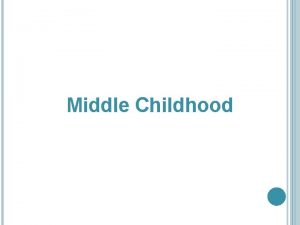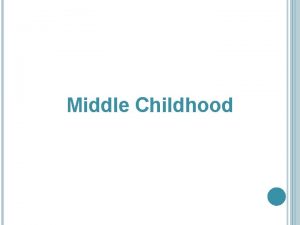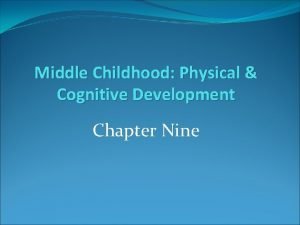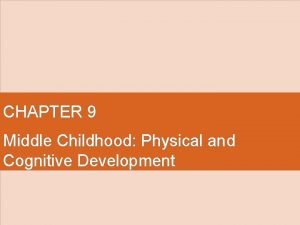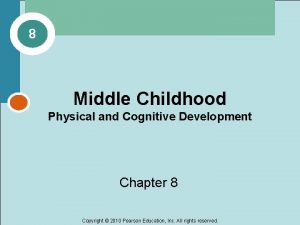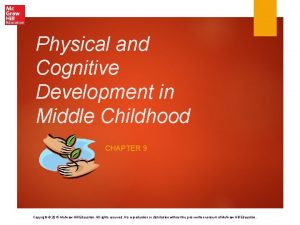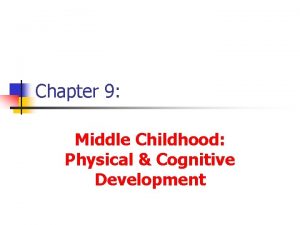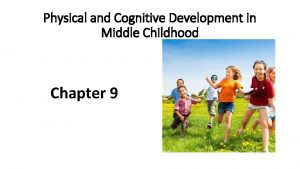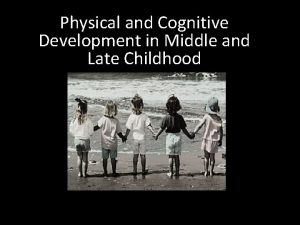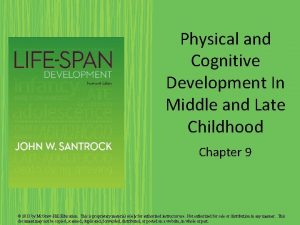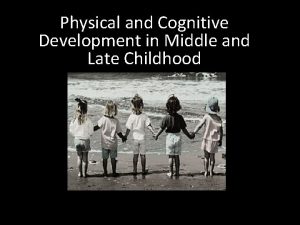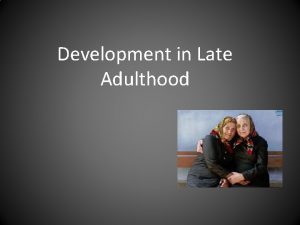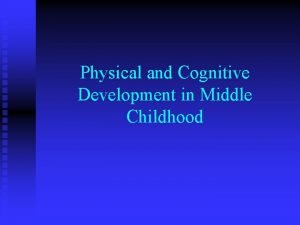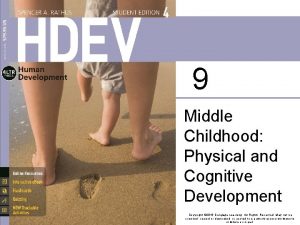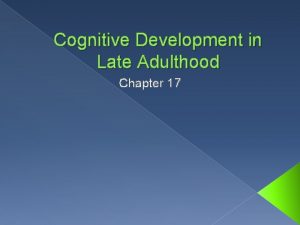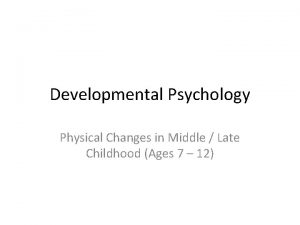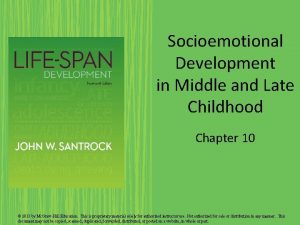Physical Cognitive Development In Middle Late Childhood Chapter
























- Slides: 24

Physical & Cognitive Development In Middle & Late Childhood Chapter 9 Manisha Sawhney, Ph. D. 1

Body Growth & Change § Slow, consistent growth § Average growth is 2 -3 inches a year § Average weight gain is 57 pounds a year

Brain & Motor Development § Brain development § Prefrontal cortex-increase in pathways and circuitry § Cerebral cortex-thickening of temporal & frontal lobes § Synaptic pruning § Motor Development § Gross Motor skills § Fine motor skills

3 year old’s drawing

5 year old’s drawing

9 year old’s drawing

Health, Illness & Disease § Injuries are the leading cause of death § Obesity The percentage of children aged 6– 11 years in the United States who were obese increased from 7% in 1980 to nearly 18% in 2012. (CDC, 2013) § Causes of Overweight/Obesity § Heredity (Stunkard et al. , 1990) § Environmental § Socioeconomic status

Consequences of overweight § Medical problems § Diabetes § Hypertension § Elevated blood cholesterol § Psychological § Low self esteem § Depression § Eating disorders

Obesity Stigma § How does social stigma of obesity effect children?

Health, Illness & Disease § Cardiovascular disease (CVD) § Risk factors for CVD include, hypertension and obesity § Cancer § Second leading cause of death in 5 -14 yr old § Leukemia most common childhood cancer

Children with Disabilities § What disabilities do children have and how does it impact their education § 14 percent children received special education in 2008 -2009 (Aud et al. , 2011) 11

Learning Disorders § Difficulty in understanding or using spoken or written language or in doing mathematics. • DSM-5 describes several domains of specific learning disorder: - Reading (dyslexia) - Written expression (dysgraphia) - Mathematics (dyscalculia)

Attention Deficit Hyperactivity Disorder § Predominantly: § Inattention § Hyperactivity § Impulsivity Incidence: § 6. 4 million children between the ages of 4 and 17 (11 percent) have received an ADHD diagnosis (CDC, 2011) § In North Dakota, the rate has increased from 7. 5 percent in 2007 to 8. 9 percent in 2011 § What do these figures tell us? § Is ADHD overdiagnosed 13

Causes for ADHD § Genetic factors § Maternal health during pregnancy § Executive areas of the brain are underactive § Treatment: § Combination of medication and behavior management improves the behavior of children with ADHD

Autism Spectrum Disorder (DSM-V) § Characterized by significant impairments in : § Social and communication deficits § Repetitive behaviors and fixated interests § Symptoms must be present in the early developmental period § Autism and Asperger disorder § https: //www. youtube. com/watch? v=z 8_Oi 9 Usg. OI

Repetitive Behavior and Fixated Interests § Prevalence § Current official U. S. estimates: 1 in 68 (CDC, 2014) § More in boys than girls § Causes § Brain dysfunction § Genes & Heredity § Polygenic model/theory of multi-factorial inheritance

Cognitive Development: Piaget’s Theory § Concrete Operational Stage: § Seriation § Transitivity § Reversibility § https: //www. youtube. com/wat ch? v=g. A 04 ew 6 Oi 9 M 17

Information Processing: Baddeley's model of working memory § Long Term Memory increases § Strategies for Improving Memory § Fuzzy Trace Theory § Verbatim memory trace § Gist 18

Intelligence § The ability to solve problems and to adapt and learn from experiences. § Intelligence Scales § Binet Test § IQ=Mental Age/Chronological Age *100 § The Wechsler Scales 19

Types of Intelligence § Sternberg’s Triarchic Theory of Intelligence 20

Gardner’s Multiple Intelligence 21

Differences in IQ scores § Influence of genetics § Environmental Influences § Flynn Effect IQ scores have risen across developed countries in recent decades. Source: Flynn (1999) 22

Culture free tests 23

Language Development § Increase in Vocabulary due to formal schooling § Start understanding comparatives and subjectives § Bilingualism and Second Language Learning § Increase globalization has lead to increase in children who are bilingual § Bilingualism does not interfere with primary language 24
 Physical development of late childhood
Physical development of late childhood Late childhood physical development
Late childhood physical development Socio-emotional development of late childhood
Socio-emotional development of late childhood Language development in middle childhood
Language development in middle childhood Physical development in middle childhood chapter 11
Physical development in middle childhood chapter 11 Physical development in middle childhood
Physical development in middle childhood Kellogg drawing stages
Kellogg drawing stages Early childhood is ____ for language learning
Early childhood is ____ for language learning Early and middle childhood
Early and middle childhood Middle and late childhood
Middle and late childhood Social development in middle adulthood
Social development in middle adulthood Stages of growth and development from infancy to adulthood
Stages of growth and development from infancy to adulthood Intellectual development in later adulthood
Intellectual development in later adulthood Module 47 infancy and childhood cognitive development
Module 47 infancy and childhood cognitive development Cognitive development in childhood
Cognitive development in childhood Module 47 infancy and childhood cognitive development
Module 47 infancy and childhood cognitive development Middle childhood emotional development
Middle childhood emotional development Social and personality development in middle childhood
Social and personality development in middle childhood Middle childhood growth and development
Middle childhood growth and development Cognitive development for middle adulthood
Cognitive development for middle adulthood Cognitive development middle adulthood
Cognitive development middle adulthood Later adulthood physical development
Later adulthood physical development Physical development in late adulthood
Physical development in late adulthood Adulthood development stages
Adulthood development stages Physical development in early childhood
Physical development in early childhood

